Bełżyce
Borough of Bełżyce, Lubelski District, Lubelskie VoivodshipType of place
The new Jewish cemetery at Przemysłowa street and the square next to the current culture center.Information about the crime
The first mass execution in Bełżyce took place on June 16, 1940, 13 people (10 Jews and 3 Poles) were shot in retaliation for killing of a German. In December 1940, a ghetto was created in Bełżyce by the decision of the German district starost. At Południowa street, not only the pre-war inhabitants of the city were crowded, but also Jews brought from, among others, Krakow and Lublin, as well as from German Thuringia and Saxony. In March 1942, the number of Jews in the Bełżyce ghetto was 4,854. For comparison, in September 1939, the Jewish community in Bełżyce numbered 2,754 people (Jadczak S. “Bełżyce. Monograph of the town and borough”, Bełżyce 2002 p. 82).
In the summer 1942, the action of gradual liquidation of the Bełżyce ghetto began. „[…] a significant part of the inhabitants were sent in three transports to the concentration camp in Majdanek. The Jews had to walk from Bełżyce to the railway station in Niedrzwica (approx. 10 km). It was a death march because the Germans were shooting those who stopped in the march. On October 2, 1942 another transport of Jews from the Bełżyce ghetto left for the extermination camp in Sobibór and was immediately sent to gas chambers. During the preparation of this transport, Germans shot about 150 elderly and infirm Jews on the square in front of the synagogue. The remaining residents were gathered in houses around the ruined synagogue. ” (Jadczak 2002 pp. 83-84).
The deportation of the Jews from Bełżyce to Sobibór was also remembered by the witness, Jan D.: „In the summer of 1942, the Germans came at night, together with the Ukrainians, they surrounded the town and ordered the Jews to gather in the square near the synagogue. Then they went around Jewish houses and checked whether the Jews are not hiding there. If they found a Jew, they killed him on the spot. The crowd gathered near the synagogue was divided into two groups. They selected a group of young people, who were able to work, they put them into the cars and took them to Majdanek. They rushed elderly and children to Niedrzwica. Those who couldn’t walk were beaten with buttstocks or killed on the spot. I was told that after they were brought to Niedrzwica, they were loaded into freight wagons covered with chloride, they were beaten with buttstocks, the doors were locked and they were taken to Sobibór.” (Files of The Regional Commission for the Examination of German Crimes in Lublin regarding the labor camp for the Jewish population operating in Bełżyce in 1942-1944, IPN Lu 284/433/1)
Most probably in the second half of 1942, the Jews who stayed in Bełżyce were crowded into a quarter of about 2 ha, where a makeshift labor camp was created. Mainly women were working in shoemaking and tailoring workshops for the needs of German army. This is what Adam Kopciowski, a historian from Lublin, writes about the camp: „For several hundred Jews who remained in Bełżyce, a labor camp was created in the synagogue building, separated from the rest of the city with barbed wire. The number of Jews in the camp continued to increase. People who had previously taken refuge in the ghetto or in the provinces, and for fear of the coming winter, were forced to leave their hiding places. In the beginning of 1943 about 1200 Jews were held in the labor camp in Bełżyce. It was managed by the commandant of the camp in Budzyń near Kraśnik, Reinhold Feiks. The work was to build a road, sorting the property and clothing from the displaced people, some prisoners also worked in quarries. The camp was liquidated in May 1943.” (History of the Bełżyce Jews, [in:] Studies in the history of Bełżyce, eds. Kazimierz Sprzeniec and Maria Walczak-Gruner, Bełżyce Regional Society, Bełżyce 2006)
The description of the camp was provided by Stanisław S., who was the mayor of Bełżyce during the war: “In 1942 or 1943 in spring or summer they [Jews] were resettled to Południowa street (now Tysiąclecia street). This area was approximately 1.5 to 2 ha. In about 6 months the area was fenced off with barbed wire. In this area there were: a school, a synagogue, a bathouse and two residential houses.” (testimony from July 1967, IPN Lu 284/433/1)
The largest massacre of the Jewisch population of Bełżyce during the war took place on May 8, 1943. In the decision taken in April 1970 to close the investigation about the murders commited by German officers in the Jewish labor camp in Bełżyce, this day is described with these words: „In the end of May 1943, the Germans arrived, and with the help of the Ukraininas remaining in their service they liquidated the camp that existed for about a year. They selected healthier Jews, rushed them on foot to Nierzwica, and from there they took them by trains to various camps. The remaining Jews, mostly sick and old people, women and children were shot with machine guns on the Jewish cemetery and buried there. According to reports of witnesses that were burying the bodies, the estimated number of victims was about 150-600 adults and children. The latter were murdered with axes by the Ukrainians. (IPN Lu 284/433/1)
The liquidation of the camp took place in front of the eyes of other residents of Bełżyce, as it was located in the center of the town. Importantly, the camp was located in one of two Jewish cemetaries, the old one founded in the sixteenth century. This fact is confirmed in the testimony of Stanisław A.: „A ghetto was created from the rest of the population, who had not been sent to Niedrzwica. The area in the vicinity of the Jewish cemetery was surrounded with barbed wire. […] There were about 2,000 Jews in the camp.” (IPN Lu 284/433/1)
The same witness confirms that in the area of the old cemetery there are mass graves of the victims of the final liquidation of the camp in May 1943: „[…] The remaining part, which was not deported, was grouped in one place. They were ordered to dig pits in the cemetery. After the pits were dug, all people, who remained, were shot.” (IPN Lu 284/433/1)
Wincenty D. also mentions about burying the victims in the old cemetery. He also adds that some of the bodies were exhumed and brought to the new cemetery in Bełżyce near Przemysłowa street, and were buried there: „In the place of the ghetto – old Jewish cemetery – there is a health center and other public buildings. I saw myself that the bodies of the murdered Jews had been exhumed and taken to the new Jewish cemetery that is fenced and planted with trees.” (IPN Lu 284/433/1) The transfer of the bodies of the victims from the graves at the synagogue is also confirmed by Stanisław Ć. (IPN Lu 284/433/1 p. 40)
On the other hand, the above-quoted Stanisław S., the mayor of Bełżyce during the German occupation, testified in 1967 that the bodies of the Jews murdered in May 1943 are still buried in mass graves in the area of the former camp: „The bodies of the murdered were buried in the camp. I did not see anyone transporting the bodies from the camp to another place. Currently there are buildings in this place, such as a clinic, a pharmacy and a culture center.” (IPN Lu 284/433/1)
According to the reports of direct witnesses of the masacre, on May 8, mainly women and children were murdered in the camp. According to surveys of the Regional Commission for the Examination of German Crimes in Lublin, about 800 women and 200 children were killed that day. (IPN Bu 2448/530 i IPN Bu 2448/531)
Jan W.: „They selected all the Jews, the young and healthy were deported, while the Jewish women I saw being killed. This was done in such a way that they were ordered to undress to their underwear in the square and one of the Germans would open the gate and let two or three Jewish women into the second German who was waiting in the cemetery near the pit. The one with the sleeves rolled up stood over the pit, made them kneel or lie down and shot them in the back of the head, killing them. I saw one Jewish woman refusing to lie down or kneeling down then, after killing two other women, the German grabbed her by the neck, pushed her downwards and shot her there. It was said that 600 or 700 people were killed this way. Two large pits were filled with bodies.” (IPN Lu 284/433/1)
Julian A.: „The liquidation [of the camp] took place on May 8, 1943 or 1944, I don’t remember exactly. On that night, the Ukrainians came with the Germans and surrounded the ghetto, ordered the Jewish men to dig a long pit in front of the synagogue, and ordered Jewish women to undress and shoot them. As I remembered, there could have been 500 of them. I know it from the fact that I was looking from my apartment window, because I lived nearby. Then, all the Jews were transported to Niedrzwica. I don’t know what happened to them. While the Jews were led to Niedrzwica, they were beaten and those who couldn’t walk were killed on the spot. The bodies were loaded onto carts and taken away.” (IPN Lu 284/433/1)
The most terrible fate awaited the Jewish children imprisoned in the camp in Bełżyce. The Holocaust survivor Paula Gold: “The next morning, about daybreak, Saturday, May 8, we heard shouting. We knew it was the end. We heard men calling, “Heraus! Heraus, Schweinhunt!” They wanted us to come outside. My little nephew David, who was only seven, begged us to leave him in the attic because they killed children first. But we went out in front of the synagogue and my sister-in-law Dina and David huddled together. We all stood outside trembling with fear. They took the young men first, including my brother Saul and another man who would be my future husband, and made them dig a big grave for their mothers, wives and children. There was one SS man, named Feix [SS-Overscharfuhrer Reinhold Feix]. The rest of them were Ukrainians. Most of them were passing between them bottles of some kind of liquor drink. When they drank it, it made them vicious. When the grave was finished, they pushed all the men back behind closed doors, locked into a shack to prevent a riot.
My sister-in-law, my nephew and myself were huddled together and one Ukrainian told me to go outside the gate on the camp fence to a big truck. I turned and saw that they told my sister-in-law to go, too, but she pulled her son along. They wouldn’t let her take him and she wouldn’t go without him. She wanted to be with her son. I was on the truck with 100 other girls and young women and we all watched in horror as the Ukrainians told all of them to undress and kneel down by the grave. Then one by one, they shot each one in the neck and kicked them into the grave. Some of them weren’t even dead yet. Five hundred women were shot and their children had their heads hacked off. I saw a Ukrainian take beautiful little David and chop off his head. A bullet was too good for a Jewish child. I saw my nephew being carried away without his head by a drunken Ukrainian soldier. They were all buried in that one big grave in the backyard of the synagogue in Bełżyce. They let the men out and made them cover the big grave then put them on the trucks.” ((https://vha.usc.edu/testimony/54118?from=search&seg=2, accessed 4.12.2020 r.)
Jakub Szabmacher from Kazimierz Dolny, took the name of Jack Terry after the war and worked in New York as a psychoanalyst with Holocaust survivors. On May 8, 1943, he was in the ghetto in Bełżyce. He published his memoirs in 2005 in a book Jakub’s World: A Boy’s Story of Loss and Survival in the Holocaust:
„ …at dawn on May 8,1943, the day after St. Stanislaw’s day, sergeant Reinhold Feix… assembles twenty-four of the Ukrainian soldiers who work for him, and heads north for Bełżyce. “Aller Juden raus!” The Jews are routed from the synagogue and the houses. Some of the Ukrainian soldiers are positioned around the periphery of the camp… Ukrainians chop the heads off infants and the toddlers they snatch from the mothers. The older ones are led in small groups to the back of the synagogue. Those awaiting their turn hear shots. When Feix and the Ukrainians have finished 700 Jewish women and 150 Jewish children are dead… someone tells Jakub that his sister had refused to be parted from her mother, and that as a reward for her loyalty, Feix shot her first in full view of Bluma, and then murdered their mother.”
Julian A.: „The children in the ghetto were taken by a Ukrainian, laid on an outstretched blanket and killed by him with an ax.” (IPN Lu 284/433/1)
According to Stanisław Jadczak, on May 8, 1943 in Bełżyce, 750 women, 150 children and around 100 men were killed by bullets or axes. (Jadczak, 2002 p. 83)
The new Jewish cemetery in Bełżyce at Przemysłowa street was also a place of execution and mass burial of prisoners of the ghetto and labor camp in Bełżyce. „During the existence of the camp, after the harvest, Germans ordered all members of the Fire Brigade to appear in the morning at the cemetery (at Przemysłowa street). I was also a member of the Brigade. When we came half an hour early, we saw 180 people from the camp, all children and elderly. After we had dug the graves they ordered us to turn around and they shot the Jews with machine guns. I saw myself how the Germans, assisted by dogs, were checking whether they were all dead, if any of them showed signs of life, they killed them with pistols. After the execution, we started burying the bodies. I remember that while we burying the bodies, a 15-year-old boy, who was alive and well, arose from the grave. At that time, Germans left and the boy was taken by his father back to the ghetto. These places are fenced off, mass and individual graves still exist in this area, trees are planted there and there is a park.” (Stanisław A. report from July 1967, IPN Lu 284/433/1)
Camp prisoners died en masse as a result of diseases of starvation, their bodies were also buried in the new cemetery. Jan D., among others, was delegated to transporting dead bodies: „[…] From 30 to 40 people died daily. I know it, because many times I took the bodies to the cemetery myself, at the request of the village leader. In the face of a large number of deaths, they were packed in paper bags and placed in layers in the grave. Such layers were sprinkled with calcium and soil, and then the next layer was covered.” (IPN Lu 284/433/1)
The other actions against the Jewish population between 1941 and 943 recorded by the Register of Killing Sites and Crimes (Warsaw 1985) include:
In 1942 the local military officers shot a 12-person Jewish family from Miłocin village (3 men, 5 women and 4 children). The bodies were buried in Bełżyce. The details of this crime are described in the survey of the Chief Commission for the Examination of German Crimes in Poland: „Twelve Jewish people lived in the village of Miłocin in the lubelskie district. The father of this large family consisting 12 of people (3 men, 5 women and 4 children) had a shoemaking workshop and thus earned his living. The rest of the family worked in the manor. In the summer 1942, the Jews were ordered to come to Bełżyce and report to the German administration authorities. After they fulfilled this command, the German military police shot the whole family in Bełżyce. The property of these Jews was robbed by Germans.” (IPN BU 2448/531)
On July 28, 1943, the military police shot two women of Jewish origin. No data about the victims personal details and the place of burial were found.
In June 2019, the representatives of the Zapomniane Foundation and the Rabbinical Commision visited the burial place of the Bełżyce camp/ghetto prisoners. On the spot, they met a resident of Bełżyce (born 1925), who lived in the vicinity of the Bełżyce ghetto, later a labor camp. Józef confirmed that there is a grave of about a thousand murdered Jews in the immediate vicinity of the present culture center. According to his account, in the 1960s, during the construction of the culture center, human remains were found:
„In the 1960s they started to build the culture center, the one that stands here now. The ritual bath house was still there and the school as well [the mikveh house, i.e. the ritual bathhouse survived the war, as well as the house of the famous tzadik of Bełżyce – Szmul Jakubson, grandson of the equally famous rabbi of Bełżyce – Kelman Icak Jakubson, where the Jewish school was located – S. Jadczak 200 p. 83], and they already started building the culture center, in the 1960s. And the excavator came, there weren’t any pits dug here, just to make the foundations. I remember, they brought four or five crates and while the excavator was digging, they found bones somewhere, then they put them into these crates, they filled these crates, took them, and the rest was cemented and now the culture center stands on this [grave].” (Bełżyce, 14 June 2019)
Józef also remembers the murder of the children from the Bełżyce ghetto:
„After all of them were killed [Jews from the labor camp in May 1943], these children stayed in this school, and then the village leader gave the order, the carts came, ten of them, the Ukrainians came, two Ukrainians on each cart, and they put the children on those carts, they transported them to Przemysłowa street and killed these children there.
- The grave is somewhere in the corner?
- In the left corner, next to the GS building, these children were killed there. And the ghetto was over.” (Bełżyce, June 14, 2019)
IDENTIFICATION OF THE GRAVE BASED ON NON INVASIVE RESEARCH
On June 6, 2019 a site inspection was carried out in the place (GPS: N51°10.413′ E022°16.919′) indicated by a witness, at Tysięclecia 26 street (Culture Center). According to a witness’s description, the mass grave is located near the eastern wall of the culture center building.
As a result of the aerial photography survey, a photograph with the reference number GX67 frame 109 (date unknown), was obtained. It was analysed in order to determine two locations of mass graves of about 1000 victims. The first location is the area at Tysiąclecia 26 street, the second location is the Jewish cemetery at Przemysłowa street. At Tysiąclecia street, there is a building (Synagogue) visible, standing on the edge of today’s Tysiąclecia Street. Behind the building towards the south there is a clear large depression in the ground. This pit is very likely a mass grave of the murdered victims in May 1943, described by a witness. The second location subject to interpretation is the Jewish cemetery at Przemysłowa street, described as the place of mass burials of the victims. In the case of a cemetery, the indicated location of one of the graves is the south-eastern corner of the cemetery. Oblong soil ground disturbance (running along the north-south axis) in the south-eastern corner of the cemetery is clearly visible on the aerial photography (marked with red arrows). Moreover, the archival photo shows numerous ground disturbances in the northern, central and southern parts of the cemetery (marked in orange).
The LiDAR survey confirms ground disturbances in the south-east corner, but also extensive sinkholes running through the cemetery along the north-south axis. Some of the above-mentioned ground disturbances coincide with those visible in the aerial photograph. Taking into consideration the large formats of visible depressions its origins may be numerous.
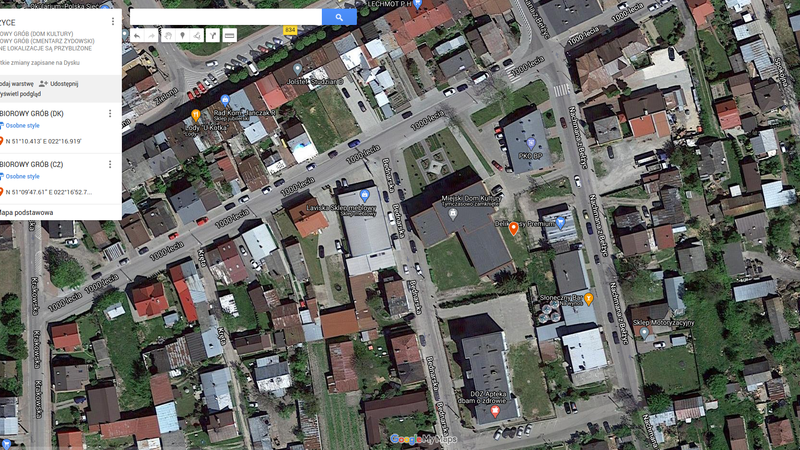 fotografia satelitarna 1a Bełżyce
fotografia satelitarna 1a Bełżyce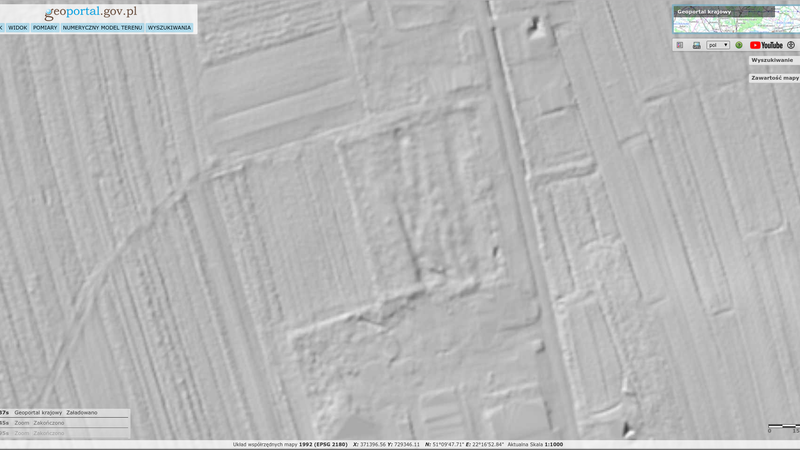 LiDAR 1 Bełżyce
LiDAR 1 Bełżyce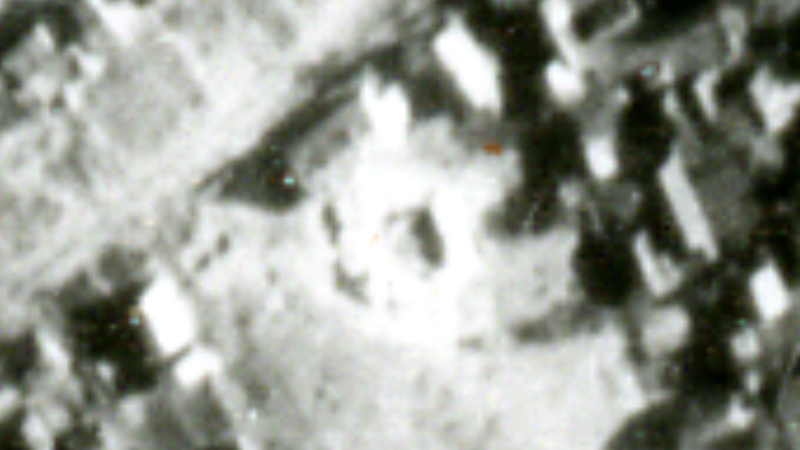 fotografia lotnicza kadr1a GX67frame 109 Bełżyce
fotografia lotnicza kadr1a GX67frame 109 Bełżyce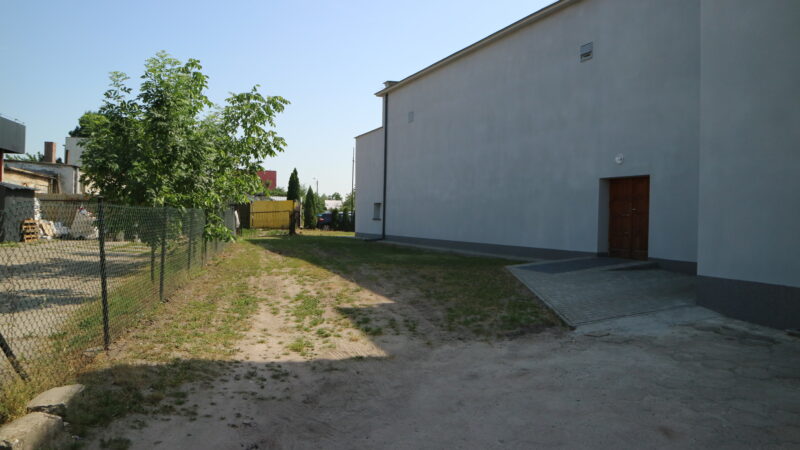 fotografia 1 lokalizacji Bełżyce
fotografia 1 lokalizacji BełżyceSources
Transkrypcje
Contact and cooperation
We are still looking for information on the identity of the victims and the location of Jewish graves in Bełżyce. If you know something more, write to us at the following address: fundacjazapomniane@gmail.com.
Bibliography
IPN Lu 502/7, The Register of Killing Sites and Crimes committed in the area of Bełżyce district, lubelskie voivodeship (1 original copy). IPN LU 500/88, repressions against the Jewish population before the creation of the ghetto in Bełżyce.
IPN Lu 501/1/1, Surveys of the Regional Commission for the Examination of Crimes against the Polish Nation in Lublin collected in the years 1969-1973 on the killing sites and crimes of Germans in the area of Bełżyce, Bełżyce district, gr. Chodel …
IPN BU 2448/530, The surveys The Chief Commission for the Examination of German Crimes in Poland and the Regional Commission for the Examination of Crimes against the Polish Nation in Warsaw, collected in 1968-1972. Surveys regarding the lubelskie Voivodeship -VIII. Bełżyce district: surveys.
IPN BU 2448/531, The surveys The Chief Commission for the Examination of German Crimes in Poland and the Regional Commission for the Examination of Crimes against the Polish Nation in Warsaw, collected in 1968-1972. Surveys regarding the lubelskie Voivodeship -VIII. Bełżyce district: surveys.
IPN GK 163/15, Questionnaire. Executions. Graves. Lubelskie voivodeship; vol. IV; Questionnaires about mass executions and mass graves – lubelskie voivodeship, 1939-1945.
The Register of Killing Sites and Crimes committed by the Germans in Poland between 1939 and 1945. Lubelskie voivodeship, ed. The Chief Commission for the Examination of German Crimes in Poland, Warsaw 1985, pp. 13, 21, 114.
Thematic file of The Chief Commission for the Examination of German Crimes in Poland, Photocopy of files from Ortskommandantur I/524 from 1943, Bełżyce district, lubelskie voivodeship, p. 126.
IPN Lu 284/433, vol. 1, Crimes committed in 1942-1944 by the staff of a labor camp for Jews in Bełżyce, Bełżyce district, i.e. an offense under Art. 1 point of the Decree of August 31, 1944 – main files, [CD-ROM].
IPN Lu 284/433, vol. 2, Crimes committed in 1942-1944 by the staff of a labor camp for Jews in Bełżyce, district Bełżyce, i.e. an offense under Art. 1 point of the Decree of August 31, 1944 – reference files, [CD-ROM].
State Archives in Lublin JA.6341.212.2019 – map of Bełżyce from 198(7) [CD-ROM].
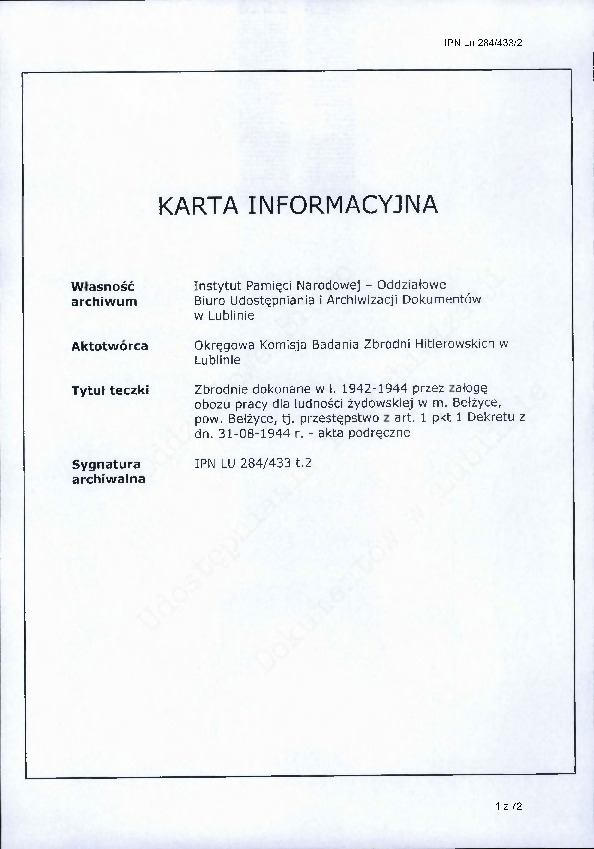 Bełżyce Karta Informacyjna IPN Lu 284/433 - 2pdf
Bełżyce Karta Informacyjna IPN Lu 284/433 - 2pdf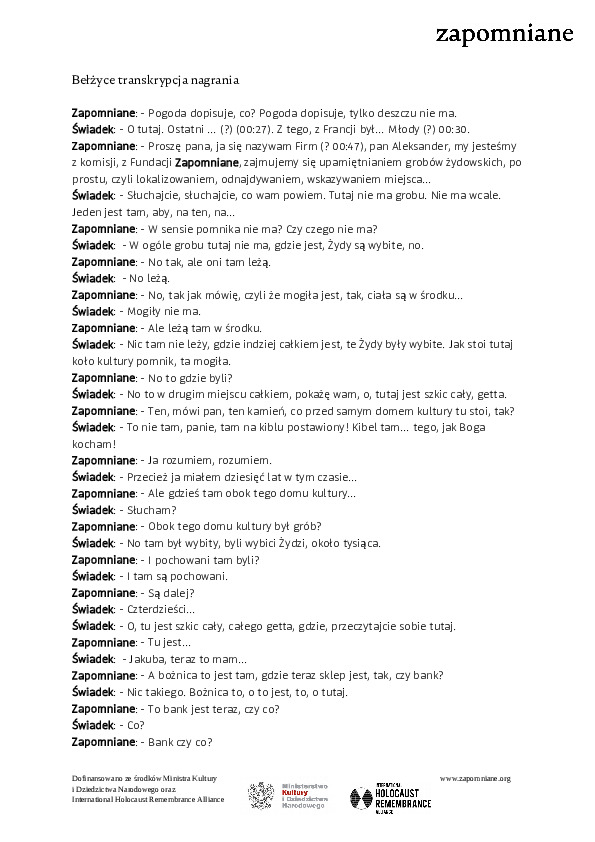 Bełżyce transkrypcja nagrania
Bełżyce transkrypcja nagrania